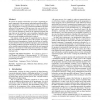Free Online Productivity Tools
i2Speak
i2Symbol
i2OCR
iTex2Img
iWeb2Print
iWeb2Shot
i2Type
iPdf2Split
iPdf2Merge
i2Bopomofo
i2Arabic
i2Style
i2Image
i2PDF
iLatex2Rtf
Sci2ools
110
click to vote
POPL
2012
ACM
2012
ACM
Resource-sensitive synchronization inference by abduction
We present an analysis which takes as its input a sequential program, augmented with annotations indicating potential parallelization opportunities, and a sequential proof, written in separation logic, and produces a correctly-synchronized parallelized program and proof of that program. Unlike previous work, ours is not an independence analysis; we insert synchronization constructs to preserve relevant dependencies found in the sequential program that may otherwise be violated by a na¨ıve translation. Separation logic allows us to parallelize fine-grained patterns of resource-usage, moving beyond straightforward points-to analysis. Our analysis works by using the sequential proof to discover dependencies between different parts of the program. It leverages these discovered dependencies to guide the insertion of synchronization primitives into the parallelized program, and to ensure that the resulting parallelized program satisfies the same specification as the original sequential...
| Added | 25 Apr 2012 |
| Updated | 25 Apr 2012 |
| Type | Journal |
| Year | 2012 |
| Where | POPL |
| Authors | Matko Botincan, Mike Dodds, Suresh Jagannathan |
Comments (0)

